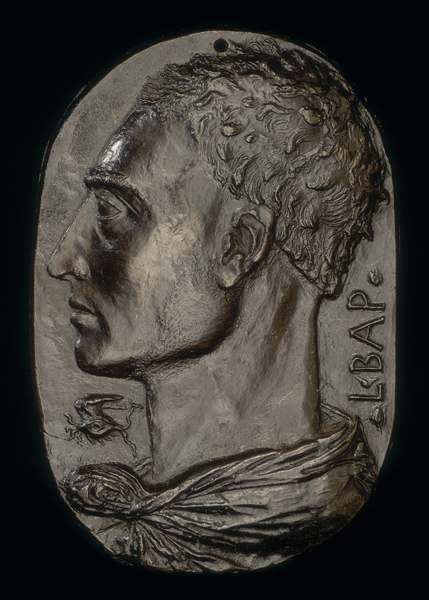Portraits

Leon Battista Alberti
Self-Portrait, c. 1435
Bronze, 20.1 x 13.6 cm (7 15/16 x 5 5/168 in.)
National Gallery of Art, Washington, DC, Samuel H. Kress Collection
Image courtesy of the Board of Trustees, National Gallery of Art
1) Q: One of these portraits represents a Roman of the first century BCE and the other represents an Italian of the fifteenth century CE. Can you guess which is which? Support your choice with visual evidence.
A: Use the discussion as an opportunity for students to look closely at the style of hair or the drapery. After a few minutes, identify the portraits.
2) Q: What ancient Roman features did Alberti imitate in his self-portrait?
A: Responses might include:
- Metal material (specifically, bronze)
- Profile of head
- Classical drapery (see the cloak loosely tied over the throat)
- Vertical inscription
- Caesar: DIVI.IVLI. (that is, Divi Juli, Latin for “of the deified Julius”)
- Alberti: .L.BAP. (abbreviation of Leobaptista)
- Personal devices
- Caesar: a lituus, or curved ritual staff that is used by augurs and priests and symbolizes Caesar’s supreme authority
- Alberti: a winged human eye that is symbolic of divine omniscience, which inspires the scholar and artist to be all-embracing in the pursuit of knowledge

16th-century cast, after ancient model
Julius Caesar
Bronze/light brown patina, diameter 4.1 cm (1 5/8 in.)
National Gallery of Art, Washington, DC, Samuel H. Kress Collection
Image courtesy of the Board of Trustees, National Gallery of Art
3) Q: Alberti was a polymath: an author, artist, architect, poet, priest, linguist, and philosopher. Why would this quintessential “Renaissance man” have chosen to represent himself according to ancient conventions?
A: Responses might include:
- Emulation: To signal his admiration for classical culture, affinity for its cultural values, and respect for its contributions to civilization
- Competition: To suggest that he is the equal or rival of the great men of antiquity and that his reputation will prove as enduring
4) Q: Apart from its reference to ancient art forms, why would someone want a portrait in the form of a medal?
A: Responses might include:
- It is small, which means it can be carried easily and shared, and it is intrinsically intimate and private.
- The metal material is highly durable.
- It is cast from a mold and can therefore be reproduced.